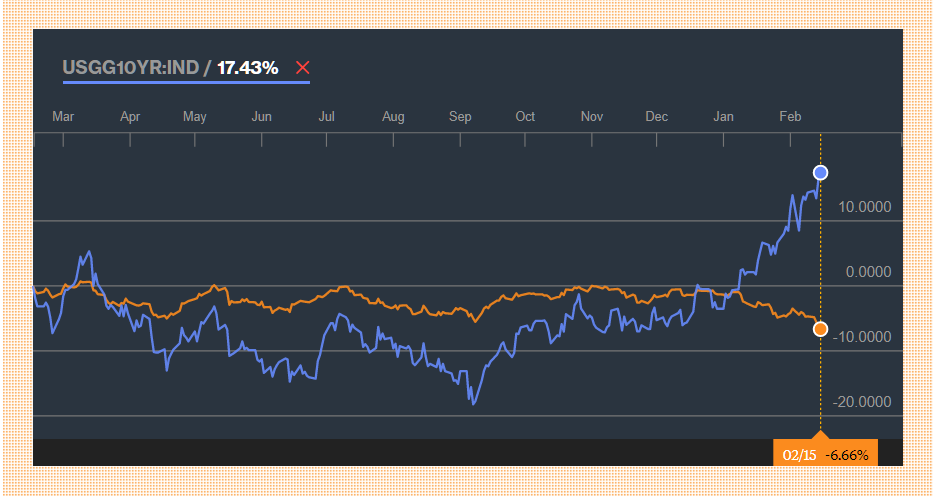By Michael O’Neill
In 1967, the Beatles invited you to “Roll up! roll up for the magical mystery tour.” Global financial markets extended a similar invitation recently. In the past few weeks, equity, bond, and foreign exchange prices went on a mystery tour of their own. Prices in different asset classes traded erratically and in directions that were, counter-intuitive to usual market conventions. It has been a collective trip, but instead of” peace, love, and groovy, the air filled with expletives.
Economic theory 101 says that rising interest rates strengthen a country’s currency due to demand from global investors seeking higher returns on their investments.
That theory came under scrutiny on February 14.
US January CPI data rose 0.5%, month over month, well above the 0.3% forecast and December’s 0.2% gain. Also, the 2.1% increase, year over year, exceeds the Federal Open Market Committee’s (FOMC) goal of needing inflation at 2.0% to justify increasing interest rates. Bond traders reacted immediately. The 10-yr. yield shot up to 2.944% from 2.822% prior to the data.
The US dollar reacted in textbook fashion. It soared. And then the rally went off the rails. Suddenly, FX traders decided that it wasn’t an interest rate story but a global growth story.
Weaker than expected US Retail Sales data for January and a rise in Business inventories suggested that the pace of domestic economic growth was slowing while the global growth outlook was increasing.
The US dollar tanked. EURUSD which had dropped to 1.2277 from 1.2345 after the inflation data, rocketed to 1.2470 before the day ended.
The interest rate/US dollar disconnect is not just a one-day story either. On February 5, EURUSD was trading at 1.2310 and US 10-year Treasury yields were 2.70%.
On February 15, they were 2.92% and 1.2485, respectively.
The Japanese yen performance is another head-scratcher. At the beginning of the year, major bank economists were forecasting USDJPY to trade in the 114.00-115.00 area by March because of rising global growth, and higher global yields.
That view was right for less than a week. USDJPY rose to 113.38 on January 8. The 10-yr. yield was 2.48%. It is trading at 106.25 on February 15 and the 10-yr. yield is at 2.92%
Chart: USDJPY and 10 yr. US Government Bond yield

Source: Bloomberg.
Wall Street may have had a private magical mystery tour. It has gone from setting record highs almost daily in January, to setting records for intraday declines in February.
The Chicago Board Options Exchange (CBOE) Volatility Index is a measure of stock market volatility. VIX futures is how its traded. Some analysts believe that derivative VIX products worsened the equity market losses in the week of Feb 5, when prices collapsed. They may have a point. Still, market veterans understand prices rarely move in a straight-line. Corrections are inevitable. Bank of England Governor Mark Carney sort of agrees. He welcomed the injection of two-way risk into the market in a speech last week.
The threat of rising interest rates has not deterred stocks from rising. The Dow Jones Industrial Average (DJIA) has climbed for five consecutive days since bottoming out on February 8. The S&P 500 is sitting in the middle of its January-February range (2581-2872.87, perhaps a sign of market indecision.
The Canadian dollar is also a victim of global market malaise. Last month, Bank of Canada raised interest rates by one-quarter of a percentage point. (0.25%) Governor Stephen Poloz justified the action saying the Canadian economy was operating close to its potential level of activity and that inflation was close to its 2.0% target. He noted that labour market slack was narrowing and doing it sooner than expected.
A series of mixed to softer US economic reports and renewed speculation that European Central Bank policy normalization was in the pipeline, led to broad US dollar selling and the Canadian dollar got a lift as well.
The equity market meltdown sent USDCAD soaring. Prices rose from 1.2255 to 1.2685. They have since recovered and are waffling in a 1.2450-1.2550 range.
On February 22, minutes from the January 31 FOMC meeting will be available. There is a new Chairman, Jerome Powell. Is he as dovish as Janet Yellen? Maybe not. CNBC, in an article, noted he was concerned about the long-run ramifications that extreme easing caused. There are more than a few major bank economists projecting 4 interest rate hikes in 2018. (the majority view was for three). What happens if inflation continues to ratchet higher? There are still a lot of people who remember the 1981 inflation fight that saw overnight rates in the US hit 20.61 %. Fed officials are loathed to repeat that exercise. They may be extra-vigilant to ensure inflation doesn’t get out of hand. Today, the Fed Funds range is 1.25% to 1.5%. Four more increases mean a year-end rate of 2.25% to 2.50%. Throwing two fifty point hikes into the mix wouldn’t be the end of the world. The top of the range would only be 3.0%. Rates were never lower than 3.24% from July 1963 until September 2001.
A spike in inflation that forced the Fed to increase the pace of rate hikes would put an end to the magical mystery tour allowing the US dollar and US interest rates to become positively correlated again.





